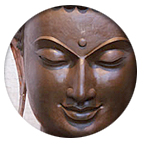 Anger. Jealousy. Impatience. Shock. Desire. Frustration. We spend our days bombarded by emotions. And if we let them, they can derail us. You know: The email you shouldn’t have sent. The snappy retort you shouldn’t have verbalized. The black funk that keeps you from seeing any joy. Fortunately, it doesn’t have to be this way. We simply need to recognize harmful emotions in the moment—and let them go. That is the crux of Trungram Gyalwa Rinpoche’s Three Moment Method™.
Anger. Jealousy. Impatience. Shock. Desire. Frustration. We spend our days bombarded by emotions. And if we let them, they can derail us. You know: The email you shouldn’t have sent. The snappy retort you shouldn’t have verbalized. The black funk that keeps you from seeing any joy. Fortunately, it doesn’t have to be this way. We simply need to recognize harmful emotions in the moment—and let them go. That is the crux of Trungram Gyalwa Rinpoche’s Three Moment Method™.
 In a talk given at Virginia Polytechnic Institute and State University, Rinpoche explains his Three Moment Method™ meditation practice emphasizing his Third Moment™ training.
In a talk given at Virginia Polytechnic Institute and State University, Rinpoche explains his Three Moment Method™ meditation practice emphasizing his Third Moment™ training.The Background
Time is one of our most precious commodities. It’s scarce. Some days you may not have an hour to meditate. You need practical tools that can be deployed in real time, as part of your daily life. Rinpoche developed the Three Moment Method™ to meet that need. Distilling key Buddhist tenets understood over millennia—such as emptiness and impermanence—it is immediate, practical and extremely effective. And it only takes a few seconds.
The Foundation
Our experience of any emotion can be broken into three moments. In the steps of the Three Moment Method™, Rinpoche emphasizes the Third Moment™ training as being the most important.
First Moment: Sensing
What happens: Your sensory organs—your eyes, your ears, your nose—perceive some sort of input. You may even react to it physically, for instance, by turning your head in the direction of a sound or movement. But in the First Moment you have not yet had a reaction.
Second Moment: Arising
What happens: You have an instant, subconscious reaction, classifying the event as good, bad or neutral.
Third Moment™: Watching
What happens: Typically, in the Third Moment you take action—either mentally or physically—in response to your emotion. If you have classified something as good, you are drawn to it, even though it may not be appropriate or beneficial to you. If you have classified something as bad you push it away, sometimes with more force than is appropriate or necessary. As a result, you may do a lot of damage that you will later need to try to undo. Rather than simply react, use the moment to be proactive.
The Practice
The Third Moment™ passes very quickly. It is easy to miss. You find it in the instant between seeing a nasty email and firing off a reply, hearing a criticism and retorting, seeing a gooey dessert and reaching for it. This is the time to stop and practice the Three Moment Method™.
- At the very instant it arises, pause. Notice the emotion you are experiencing.
- Instead of focusing on who did what to whom, simply look into your emotion.
- Imagine your emotion as an inflated balloon, filling your insides. Don’t pay attention to the edges. Concentrate on the center. No rationalizing. No reasoning. Just observation. What is inside that balloon? Nothing tangible. Just space.
The Results
By widening the gap between action and reaction, you gain space from your emotions. Your mind is cooler, clearer, less biased. You are more connected to the present moment. You become aware that your emotions are just that: Emotion, not reality. The Three Moment Method™ not only effects how you react, it effects how you interpret your experiences. With practice, you are no longer controlled by your emotions—and your reactions become far more reasonable.

LIVE BETTER
Life is complex, puzzling and often painful.
Sometimes it seems there must be a better way
to manage—and there is. It is as simple as looking
at a problem through a different lens.



